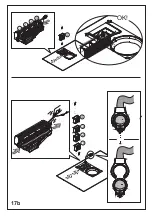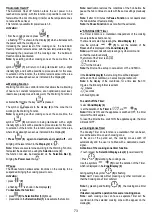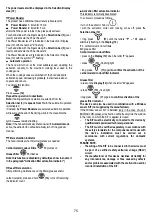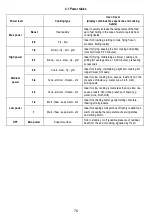
69
EN - Instruction on mounting and use
2. Use
Using the hob
The induction cooking system is based on the physical
phenomenon of magnetic induction. The main characteristic of
this system is the direct transfer of energy from the generator
to the pot.
Advantages:
When compared to electric hobs, your induction hob is:
- Safer:
lower temperature on the glass surface.
- Faster:
shorter food heating times.
- More accurate:
the hob immediately reacts to your
commands
- More efficient:
90% of the absorbed energy is transformed
into heat. Moreover, once the pot is removed from the hob,
heat transmission is immediately interrupted, avoiding
unnecessary heat losses.
Attention!
User should not put hot or warm pot and pans on
metal grille.
2.1 Cooking containers
Use only pots bearing the symbol
Important:
to avoid permanent damage to the hob surface, do not use:
- containers with less than perfectly flat bottoms.
- metal containers with enamelled bottoms.
- containers with a rough base, to avoid scratching the hob
surface.
- never place hot pots and pans on the surface of the hob's
control panel
2.1.1 Pre-existing containers
Induction cooking uses magnetism to generate heat.
Containers must therefore contain iron. Check if the pot
material is magnetic using a magnet. Pots are not suitable if
they are not magnetically detectable.
2.1.2 Recommended pan bottom diameters
IMPORTANT: if the pots are not correctly sized, the
cooking zones will not turn on
For details of the minimum pot diameter that needs to be used
on each zone, see the illustrated part of this manual.
Fig. 19
2.2 Energy saving
Recommendations for best results:
- Use pots and pans with a bottom diameter equal to that of
the cooking zone.
- Use only pots and pans with flat bottoms.
- Where possible, keep the lid on pots during cooking
- Cook vegetables, potatoes, etc. with a minimal amount of
water to reduce cooking time.
- Use a pressure cooker, as it further reduces the energy
consumption and cooking time
- Place the pot in the centre of the cooking zone outlined on
the hob.
Using the extractor fan
The extraction system can be used in two versions: external
extraction and evacuation or as a filter with internal
recirculation.
Extraction version
Fig.7
The fumes are evacuated towards the outside through a
series of pipes (bought separately) fastened to the supplied
connecting flange.
The diameter of the exhaust pipe must be equivalent to the
diameter of the connecting ring:
- for rectangular outlets 222 x 89 mm
- for circular outlets Ø 150 mm (*)
For more information, see the page relative to the extraction
version in the illustrated part of this manual.
Fig.7c
Connect the product to wall-mounted exhaust pipes and holes
with a diameter equivalent to the air outlet (connecting flange).
Using wall-mounted exhaust pipes and holes with a smaller
diameter may reduce the efficiency of extraction and
drastically increase noise levels.
All responsibility in this regard is therefore denied.
Keep duct as short as possible.
Use ducting with the least possible number of curves
(maximum angle: 90°).
Avoid drastic changes in the ducting diameter.
Filtration version
Fig. 8
The extracted air will be filtered in special grease filters and
odour filters before being sent back into the room.
The product is supplied with all parts necessary for standard
installation, with the air outlet positioned in the front part of the
cabinet plinth.
Four high-performance ceramic activated carbon filter packs
are already supplied with the product. Ceramic filters are
innovative modular carbon filters, which are regenerating (see
the Maintenance - Activated carbon filters section of this
manual).
Their chemical-physical properties allow extremely efficient
odour absorption and high mechanical resistance.
For more information, see the page relative to the filtration
version (in the illustrated part of this manual).
Fig. 13b
Summary of Contents for QHFB860P
Page 22: ......
Page 23: ......
Page 24: ...1x 1x 1x 2 8 m 4x 1x 1x 1x 1x 2x 1x 8x 4x 4x 1x 1x 4x 2x 3 5x9 5mm 1x ...
Page 25: ...KIT WINDOW ...
Page 26: ...A B ...
Page 27: ...min 50 min 500 min 40 min 40 1 N L A B ...
Page 28: ...1a 830 515 211 490 805 50 50 60 60 490 211 805 inst A P P 20 60mm ...
Page 30: ...1c 16 ...
Page 31: ...2 a b b ...
Page 32: ...2a 1 x 2 8 m inst A ...
Page 33: ...2b 1 x 2 8 m inst B ...
Page 36: ...5 4 4x OK ...
Page 37: ...6 x4 x4 x8 inst B ...
Page 38: ...7 ...
Page 39: ...e 7a 1 7a 2 7a 3 7a 4 BACK FRONT a b 1 a a b ...
Page 40: ...1 1 7a 6 7a 5 ...
Page 41: ... 600 45 490 60 50 211 550 189 488 89 227 455 7b ...
Page 42: ... 189 488 210 490 50 600 560 89 227 7b ...
Page 43: ... 7c ...
Page 44: ...8 ...
Page 45: ...9a 3 clack 600 9a 1 9a 2 2x 3 5x9 5mm clack ...
Page 46: ...e 9a 4 BACK FRONT a b 9a 5 9a 6 a a b ...
Page 47: ...1 9a 8 9a 7 1 ...
Page 48: ... 600 clack 9b 1 9b 2 9b 3 9b ...
Page 49: ...2x 3 5x9 5mm clack 9b 4 9b 5 ...
Page 50: ...e 9b 6 9b 7 BACK FRONT b a 9b 8 a a b ...
Page 51: ...9b 10 9b 9 2 1 2 1 2 ...
Page 52: ...10 94 227 55 218 1 2 3 900 ...
Page 53: ...11 3 60 441 26 50 R 10 475 5 40 5 ...
Page 54: ...12 13 H 2x X a X b L o r e m c H ...
Page 55: ...600 490 60 50 450 560 151 151 183 485 211 13a ...
Page 56: ...490 50 685 845 560 210 138 183 13a ...
Page 57: ...13b OK OK N1 E4 N3 N10 N2 E5 ...
Page 58: ...14 fig 17 fig 16 18 fig 15 ...
Page 59: ...15 16 b a a b ...
Page 60: ...17 17a 1 2 3 4 17 1 17 2 1 2 3 4 ...
Page 61: ...1 2 3 1 1 1 2 2 1 2 3 3 ...
Page 62: ...17b OK 1 2 3 4 1 2 3 4 4 ...
Page 63: ......
Page 64: ...4 3 2 1 2 3 1 2 2 2 3 4 4 3 ...
Page 65: ...17c 1 17c 1 17c 2 1 ...
Page 66: ...18a ...
Page 67: ...18b ...
Page 69: ...OK OK NO NO NO OK NO ...
Page 126: ...LIB0173376 Ed 12 20 ...
















































